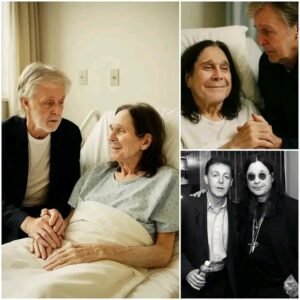For Those Looking for Pictures of a Younger, Less Crazed Ozzy – Always a Prince of the Dark
Before the biting of bats, the stumbling reality shows, and the slurred growls of “Sharon!”, there was another Ozzy—one often forgotten amid the myths and madness. For those digging through old records, magazine clippings, or YouTube rabbit holes searching for a glimpse of the younger, less crazed Ozzy Osbourne, you’ll find something far more haunting than chaos: beauty. Not in the traditional sense, perhaps, but in the rawness of a young man who carried darkness with a kind of nobility.
The early shots of Ozzy, particularly from the late ’60s and early ’70s, tell a different story than the caricature he’d eventually become. Standing beside his Black Sabbath bandmates, he looked more like a wayward poet than the “Prince of F***ing Darkness.” Gaunt face, deep-set eyes, hair long and raven-black—he often looked like someone who had seen the edge of the abyss and decided to stay a while. Not deranged, not wild-eyed. Just… dark. Controlled darkness. Intentional.
You’ll find photos of him shirtless backstage, a crucifix dangling from his neck, not as a joke but as a strange badge of contradiction. You’ll see the stage fog curling around his boots while his eyes lock dead-on into the crowd—no blinking, no smiling. This Ozzy wasn’t looking for fame; he was channeling something else, something old and primal. Even then, at just 21, there was something timeless about him. Like he had always been here.
In studio photos from the Paranoid era, Ozzy’s look was almost ethereal. His skin pale, his fingers wrapped around a mic stand like it was a rosary made for a fallen priest. He didn’t need theatrics. The music spoke for him—those guttural wails, stretched out across Tony Iommi’s demonic riffs, weren’t put-on. They were prophecy. And somehow, in those moments, Ozzy looked calm. Clear-headed, even. As if the storm hadn’t hit him yet.
But make no mistake—madness was coming.
Still, those early images hold weight because they capture him before. Before the overdose scares, the public meltdowns, the bumbling interviews. There’s something tragic about that. Not because he “lost” himself, but because he gave himself away—to music, to fans, to drugs, to the myth. And the pictures of young Ozzy tell that story in reverse. You see a man who was in complete control of his chaos, who wore darkness like a crown rather than chains.
There are candid moments, too—photos of him laughing backstage with Geezer and Bill Ward, or lounging in a hotel room with a cigarette and a bottle of whiskey. Not insane. Not broken. Just a 20-something rock star trying to navigate a world that was starting to crown him something far bigger than himself. And you can’t look at those pictures without feeling a little pang of sadness. Because you know what’s coming next.
Even the way he dressed back then had a kind of deliberate gloom. Leather, velvet, crucifixes, and those long cloaks he sometimes wore—it wasn’t for show. Ozzy wasn’t playing the Prince of Darkness. He was him. Long before Marilyn Manson, before Alice Cooper made eyeliner iconic, Ozzy walked onto stages like a gothic specter of blues and doom, and people felt it. His presence was real. No makeup could fake that.

One of the most iconic photos—black and white, 1971—shows Ozzy standing alone in a cemetery. No props. No flame. Just him, arms crossed, eyes narrowed, flanked by tombstones. He didn’t smile, and he didn’t have to. He looked like he belonged there. Like the silence of that graveyard was somehow familiar.
And maybe that’s why people are still so obsessed with these old images. Because they hold something rare. A man, not yet consumed, staring into the abyss with open eyes—and inviting it in.
Yes, there were flashes of the “crazy” Ozzy even back then. A grin here, a wild laugh there. But it wasn’t yet the core of who he was. Those came later—after the albums, after the booze, after the demons had taken more than their fair share. That Ozzy became larger than life. But this Ozzy—the young one—was still fighting to keep life real.
For those looking for pictures of a younger, less crazed Ozzy: they’re out there. You’ll find them in old magazines, in vintage Sabbath liner notes, in fan archives and dusty corners of the internet. Look closely, and you’ll see a man who wasn’t pretending to be dark—he was dark. And it wasn’t for show.
It was the truth.
He wasn’t yet screaming into voids or staggering through reality TV sets. He was still whispering secrets into microphones, eyes closed, letting the music do the damage. He wasn’t yet a punchline or a legend. He was just John Michael Osbourne—haunted, focused, and quietly building the legacy that would eventually become immortal.
So remember him that way, too. Always a Prince of the Dark.
Even before the world turned him into a mad king.
Leave a Reply